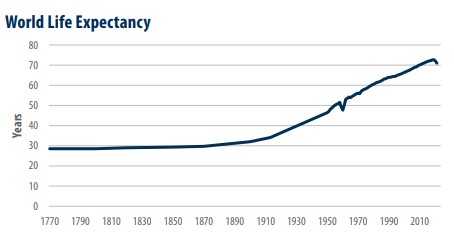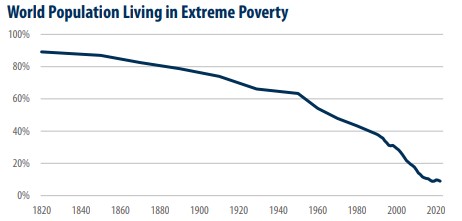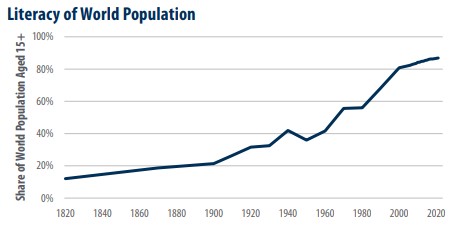Market Insights: Global Progress - A Long-Term Perspective
Milestone Wealth Management Ltd. - Oct 04, 2024
Macroeconomic and Market Developments:
- North American markets were positive this week. In Canada, the S&P/TSX Composite Index was up 0.86%. In the U.S., the Dow Jones Industrial Average increased 0.09% and the S&P 500 Index rose 0.22%
- The Canadian dollar was down this week, closing at 73.7 cents vs 74.0 cents last week.
- Oil prices surged this week. U.S. West Texas crude closed at US$74.56 vs US$68.57 last week.
- The price of gold was down slightly this week, closing at US$2,671 vs US$2,674 last week.
- The Canadian manufacturing sector moved into expansion territory for the first time since April 2023. The September manufacturing Purchasing Managers Index (PMI) came in at 50.4, up from 49.5 in August (readings above 50 indicate expansion).
- Conversely, the U.S. ISM manufacturing PMI index held steady at 47.2, the sixth straight month below 50, as 13 of the 18 industries surveyed reported contraction. However, the U.S. ISM Non-manufacturing (services) PMI rose to a 19-month high of 54.9, up from 51.5 last month.
- Calgary-based MEG Energy (MEG) announced that it has achieved its $600 million debt target and will now be transitioning to a 100% return of free cash flow to shareholders, allocated between share buybacks and a base dividend.
- DirecTV and Dish have agreed to merge, creating the largest pay-TV provider in the U.S. DirecTV will acquire Dish from its parent company, EchoStar, for $1 and assume $9.75 billion of Dish’s debt. The deal is contingent on Dish bondholders agreeing to a $1.57 billion debt reduction.
- U.S. employment numbers for September were released on Friday. Nonfarm payrolls surged by 254,000, easily beating the 150,000 expected by economists, with the unemployment rate dropping to 4.1% from 4.2% in August.
Weekly Diversion:
Check out this video: Baby Hippo Takes the World by Storm
Charts of the Week:
In our 24/7 news cycle, it's easy to get caught up in the challenges and crises that dominate headlines. However, when we take a step back and examine long-term trends, a different picture emerges – one of remarkable global progress. Let's explore three key indicators that highlight how the world has become healthier, wealthier, and more educated over the past two centuries.
Life Expectancy: A Dramatic Rise
The increase in global life expectancy is nothing short of extraordinary. In 1770, the average person could expect to live just 28.5 years. By 1900, this had only marginally improved to 32 years.
However, the 20th century saw a revolution in longevity:
- 1900: 32 years
- 2000: 66.5 years
- 2021: 71 years
This remarkable doubling of life expectancy in just over a century is attributed to advances in healthcare, sanitation, and nutrition. Developing regions have seen the most significant gains, with improved access to vaccines and healthcare driving down infant mortality rates.

Source: Our World in Data, First Trust Advisors
Poverty Rates: A Steep Decline
Perhaps the most striking indicator of improved living standards is the sharp reduction in global poverty rates. At the dawn of the 19th century, a staggering 90% of the world's population lived in extreme poverty.
Fast forward to today:
- 1820: 90% in extreme poverty
- 1960: Over 50% in extreme poverty
- 2022: Less than 10% in extreme poverty
This dramatic decline is largely due to economic development, particularly in regions like East Asia. Hundreds of millions of people have been lifted out of poverty, gaining better access to education, healthcare, and improved living conditions.

Source: Our World in Data, First Trust Advisors
Literacy: Education for All
Education is the cornerstone of development, and global literacy rates reflect significant progress. In 1960, less than half of the global population aged 15 or older could read and write.
Today, the picture is vastly different:
- 1960: Less than 50% literacy rate
- 2022: 87% literacy rate
This surge in literacy is particularly notable in developing countries, where access to education has expanded significantly. A more educated global population is better equipped to tackle complex challenges and drive further progress.

Source: Our World in Data, First Trust Advisors
While daily news often focuses on immediate problems, these long-term trends tell a powerful story of human progress. Life expectancy has more than doubled, extreme poverty has plummeted, and literacy rates have soared. In addition, as a side note and contrary to what the media projects, violent crime rates in the U.S. have dropped almost 50% from 1992 to 2022.
These improvements have touched billions of lives across the globe. As we face the challenges of the future, it's worth remembering how far we've come. This long-term perspective can inspire hope and drive us to continue working towards a better world for all.
Sources: CNBC.com, Globe and Mail, Financial Post, Bloomberg, Thomson Reuters, Richardson Wealth, Bespoke Investment Group, Usafacts.org, Our World In Data, First Trust Advisors
©2024 Milestone Wealth Management Ltd. All rights reserved.
DISCLAIMER: Investing in equities is not guaranteed, values change frequently, and past performance is not necessarily an indicator of future performance. Investors cannot invest directly in an index. Index returns do not reflect any fees, expenses, or sales charges. Opinions and estimates are written as of the date of this report and may change without notice. Any commentaries, reports or other content are provided for your information only and are not considered investment advice. Readers should not act on this information without first consulting Milestone, their investment advisor, tax advisor, financial planner or lawyer. This communication is intended for Canadian residents only and does not constitute as an offer or solicitation by anyone in any jurisdiction in which such an offer is not allowed.